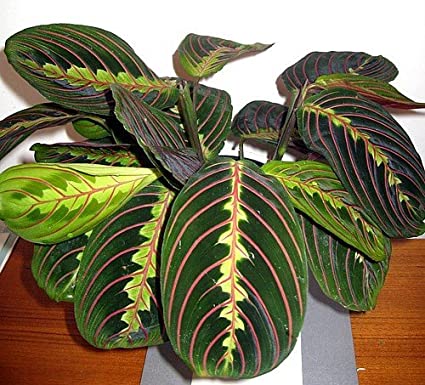Complete Prayer Plant (Maranta Leuconeura) Care Instructions
Written by Lisa
Nov 22 2022
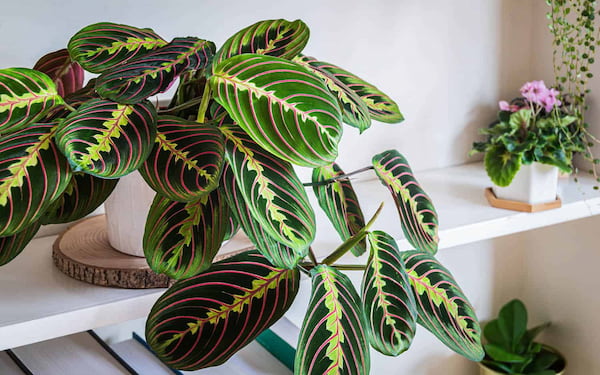
Care for a Prayer Plant by following the guidelines below. You can learn how to water a prayer plant from this guide, along with information on the plant's preferred light, temperature, and humidity levels and any other maintenance it might require to thrive.
What is A Prayer PlantPrayer Plant PicturePrayer Plant Leaves & FlowerPrayer Plant Leaf NodePrayer Plant CarePrayer Plant Light RequirementsPrayer Plant SoilPrayer Plant WateringPrayer Plant HumidityPrayer Plant TemperaturePrayer Plant Care IndoorsPrayer Plant OutdoorsRepotting Prayer PlantPrayer Plant PruningFertilizer For Prayer PlantPrayer Plant PropagationPrayer Plant Propagation In WaterPrayer Plant Division PropagationPrayer Plant Cutting PropagationPrayer Plant BenefitsPrayer Plant MeaningPrayer Plant Varieties with PicturesPrayer Plant ProblemsPrayer Plant Leaves CurlingPrayer Plant DroopingPrayer Plant Yellow LeavesIs Prayer Plant Toxic to CatsPrayer Plant Brown TipsPrayer Plant DyingPrayer Plant Root Nodules/Root BulbsPrayer Plant Root RotHow to Transplant Prayer Plant
The Prayer Plant is a popular foliage plant for its beautiful decorative leaves. Prayer Plants fold up their leaves at night and extend at day, which is very unique and interesting. Prayer plants are very commonly used as houseplants for their natural habit, but they are not easy to keeping growing if under improper care. This article will introduce what is a prayer plant with pictures and how to care for and propagate prayer plants in detail.
What is A Prayer Plant
The Prayer Plant (Scientific name: Maranta Leuconeuran) is a perennial evergreen herbaceous foliage plant, with a plant height of up to 30 cm. It is native in Brazil and other places. Prayer plants enjoy warm, moist and semi-shaded environments. Because the plant is shade resistant, it is suitable for decoration and houseplants indoors. Why is it called a prayer plant? It gets its common name Prayer plant from the fact that its leaves stay flat during the day and then fold up like praying hands at night.Prayer Plant Picture
Prayer Plant Leaves & Flower
Prayer Plant is a very beautiful foliage plant. There are many varieties, and all of them are good-looking. Prayer plants have large leaves and often have many patterns, so many people find Prayer Plants more beautiful than many flowers. Prayer plants usually flower in summer and autumn. It doesn’t clear that how long will they bloom, which depends on the growing environment and care measures. Some will bloom after growing 2-3 years, but some don’t bloom even after growing 4-5 years. Prayer plants like moist, warm, well-ventilated and well-nourished environments.Prayer Plant Leaf Node
Prayer Plant has underground rhizomes or tubers with solitary and larger leaves. There is a significantly enlarged node at the junction between the leaf and petiole of the Prayer Plant, which contains water storage cells and can regulate the direction of the leaf. That is, when there is sufficient water at night, the leaf stands upright and when there is insufficient water in the day, the leaf expands. This is a unique characteristic of the Prayer Plant.Prayer Plant Care
How to care for a Prayer Plant? Prayer Plants like to grow in a high humidity environment with appropriate light but not exposed to direct sunlight. It is afraid of the cold and the best growth temperature should be between 18 degrees and 30 degrees. Here are detailed Prayer Plants care instructions including light requirements, soil, watering, temperature, pruning, fertilizer, etc.Prayer Plant Light Requirements
Avoid direct sunlight for Prayer Plant care, which grow better under scattered light. Especially in summer, too much direct light easily cause Prayer Plants leaf burns. If leaf burns, immediately remove the plant to a place without direct light or place with shading facilities, and cut off the burned leaves to prevent other pathogenic bacteria invading from the wound. When caring for prayer plant indoors, it should be placed in bright light to grow luxuriant. If the environment is too shaded, their growth will be weak and their leaf stripes will fade.Prayer Plant Soil
Prayer Plants require fertile, loose and well-drained soil, avoid soil compaction and waterlogging. Use fertile humus soil and porous coarse medium as substrate for growing Prayer Plants.Prayer Plant Watering
Spring, summer and autumn are the peak seasons of Prayer plants growth every year. The air humidity suitable for their growth is between 75% and 85%. High air humidity is conducive to leaf expansion. Especially during the extraction of new leaves, if it is too dry, the leaf margins and tips of new leaves are prone to wither and become malformed in the future. If the Prayer plants leaves wilt, they cannot recover. Therefore, in the growing season they need frequent watering. So how often to water prayer plant. In summer, water prayer plants 3-4 times everyday timely and often spray water to the leaves. The best way to water prayer plant is to spray water to leaves in the morning, water to soil at noon or in the afternoon and water the whole plant at night. It should be noted that the soil should not be too wet and too sticky, which will cause Prayer plants to root rot. In autumn and winter, the growth rate of Prayer plants down, gradually reduce watering. According to the weather, you can decide to water Prayer Plants 1 time a day or 2-3 times a day. When the temperature is low, keep the soil dry to avoid Prayer Plants frostbite.Prayer Plant Humidity
Prayer plant likes wet environment, and the air humidity for the plant should be kept at 65%-85%. If the air humidity is not high enough, the prayer plant leaves will appear yellow, curly phenomenon which affects the ornamental value. In winter, the weather is cold but also relatively dry, so it is necessary to spray water around and on the leaves frequently during prayer plant care. A moist and cool environment is more conducive to the growth of Prayer plant.Prayer Plant Temperature
The Prayer plant is native to tropical and subtropical regions, so it likes high temperature, humid and semi-cloudy environment. The appropriate growth temperature for Prayer plant is 20-30℃, the best growth temperature is 18-21℃ in the daytime, 16-18℃ at night. In winter, the temperature for Prayer plant should be higher than 10℃. So in summer, prevent high temperature irradiation and put it in the shade; Move the Prayer plant to warm indoors in winter to avoid frostbite.Prayer Plant Care Indoors
Prayer plant not only can be placed in bright rooms for long-term viewing, but also in dark rooms for long-term viewing.The leaves of Prayer plants are colorful and grow better in places with poor light than in strong light. They are more suitable for indoor care and have a strong ability to adapt to the environment. Prayer plant can be planted in many places near green belt, park, pond, etc. It can also be used for landscaping of various ecological parks and has a decorative effect.
Prayer Plant Outdoors
Prayer plants do best in bright, indirect light but will tolerate a bit of shade. If growing Prayer plant outdoors, the most important thing is to avoid direct sunlight, as this will scorch the leaves, and keep away from draughts. Provide a minimum temperature of 15°C and avoid rooms with regular temperature fluctuations. (Find More Prayer Plant Varieties Here.)
Repotting Prayer Plant
We can repot Prayer plant every 1-2 years during prayer plant care. The best time for repotting prayer plant is in spring. Here are steps on how to repot Prayer plant.- Prepare loose breathable, well-drained soil and a larger breathable pot.
- Remove the Prayer plant from the old pot. First Loosen the pot soil and turn the pot over with your hands so that the plant will separate from the pot. Then clean up the original soil. If there is root rot on Prayer plant, it is necessary to timely trim the root and give the wound disinfection treatment at the same time.
- Grow the plant in the new pot with new soil. Water properly to keep the environment moist, pay attention to do not overwater. Put it in the shade to adapt to new pot and care for it normally after it survives.
Prayer Plant Pruning
Generally, Prayer plant does not need pruning. Pruning the yellow and wilt leaves is enough during prayer plant care. If root rot occurs, timely trim the root and repot the prayer plant.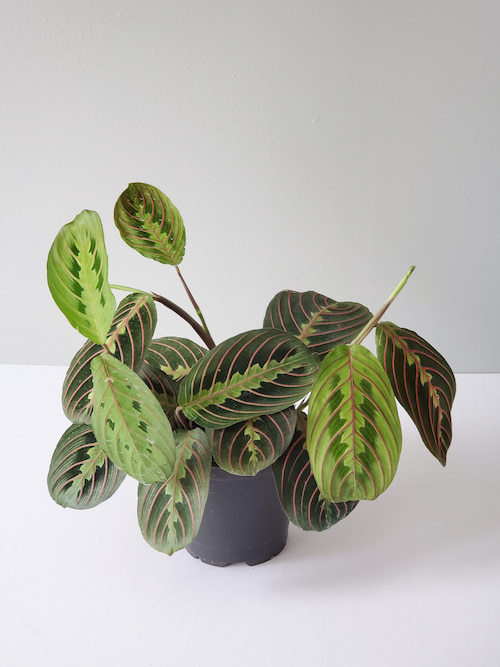
Fertilizer For Prayer Plant
Frequently apply thin fertilizer to Prayer Plant. The nutrient composition of fertilizer should be mainly nitrogen fertilizer, followed by phosphorus and potassium fertilizer. As Prayer plant is a foliage plant, increasing nitrogen fertilizer can make the leaf color more beautiful. Additional, usable urea that contains nitrogen amounts to 46% makes up 0.1% solution, add the dihydrogen potassium phosphate that contains phosphorus is more than 50%, contain potassium is more than 30% makes 0.2% solution to make additional fertilizer for root. Apply the fertilizer when dew is not dry in the morning or evening. When spraying, spray both sides of the Payer plant leaf blade with fine hole sprayer once a week, continuous spraying 3 times. Stop applying for 1 week, and then continue spraying. Special attention should be paid to the concentration of fertilization that should not be too large, otherwise it will easy to cause leaf burn even cause Payer plant wilt. Stop fertilizing during winter and when it is too hot in summer.Prayer Plant Propagation
There are three ways to propagate Prayer plant, including propagating prayer plants in water, cutting propagation and division propagation. The most common way to propagate prayer plants is division propagation. Here are details on how to propagate prayer plants.Prayer Plant Propagation In Water
It is very important to choose small and healthy plants to propagate prayer plant in water. If the plant is too large, the hydroponic container is not easy to choose, and it is easy to topple over and not easy to care.First, take out the prayer plant in soil and clean the roots with clean water. Try to clean thoroughly, otherwise the water will be turbid for a certain period of time and it will take a long time to become clear.
In the process of cleaning the root system of prayer plant, it is also necessary to prune the old and rotten roots, and then soak them in 1% potassium permanganate aqueous solution for one hour, which can kill viruses and promote their rooting as soon as possible.
Finally, plant the Prayer plant in a container and add water up to 2/3 of the root system, or drop some nutrient solution to promote growth.
Prayer Plant Care in Water
- Water timely
- Add nutrient solution appropriately
When caring, if the root of Prayer plant is found to be rotten, it is necessary to cut it off in time and wash the root with water to prevent the breeding of germs.
Prayer Plant Division Propagation
Prayer plant is generally divided for propagation. The best time for prayer plant propagation is around 20℃ in spring, but other times can be carried out as long as the temperature and humidity are appropriate. During propagation, a sharp knife is used to cut the root block with stem leaves or leaf buds; A small number of prayer plant propagation can cut with stem leaves and leaf buds of the root blocks and directly grow in the mud pot; For mass propagation, they should be placed in the seedbed; Be sure to make the temperature reach 20-28℃, humidity more than 80%.Prayer Plant Cutting Propagation
Cutting propagation of Prayer plants is generally carried out when the temperature is no less than 20℃, and it can be carried out in any season.Cuttings of Prayer plants generally use the top tender tips, and the length of cuttings should be 10-15 cm. If the leaves are growing vigorously, keep about a third of them. If the leaves are weak and small, you need to keep half the Prayer plant leaves.
Before growing, the cuttings of Prayer plant should be soaked in 500ppm neacetic acid solution and stay for 2-3 seconds. Indoleacetic acid and indolebutyric acid can also be used for treatment.
After treatment, insert the cuttings into the seedbed or pot at an Angle. If mass propagation, the rows of Prayer plants should be about 5×10 cm apart to ensure the normal growth of the plants.
Then cover with film, control temperature at 20℃ - 30℃, air humidity in 75%-85%.
The survival rate of Prayer plants cutting propagation is lower than division propagation, which is about 50%, so it is best to adopt the divition methods in prayer plant propagation at home.
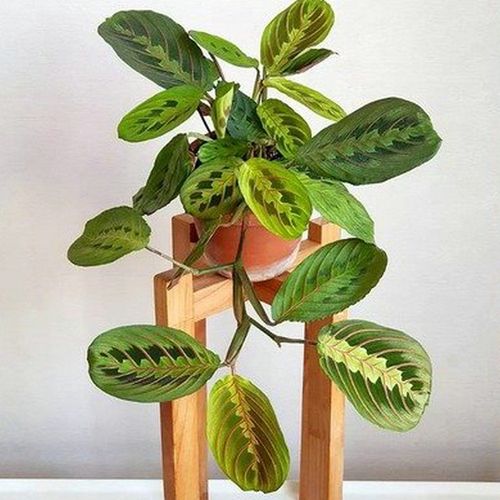
Prayer Plant Benefits
- Landscaping
- Indoor Decorative
- Potted Plants
- Medicinal Value
- Edible Value
Prayer Plant Meaning
- Temptation
- Dream
- Wisdom
Prayer Plant Varieties with Pictures
There are multiple varieties of prayer plants, differentiated by their leaf markings. Red prayer plants have rich red veins running through them, and are one of the most striking examples. The black prayer plant variety has a more olive green base, with silver markings and veins, along with purple spots. Both Green and Kim prayer plants have less prominent veins and are noted for their large spots – either green (former) or deep, deep purple (the latter).A few prayer plant species are the most common types:
- Maranta leuconeura var. erythrophylla: This tri-colored prayer plant, also called the herringbone plant, is the most common variety and features bold red veins.
- Maranta leuconeura var. kerchoveana: This variety, also known as Rabbit's Tracks, has plain green leaves with two rows of darker splotches.
- Maranta leuconeura var. massangeana: This variety has a darker leaf background with silvery blotches along the midrib and white leaf veins.
- Maranta leuconeura var. erythroneura: This variety also called Red prayer plant, which shows off dark green leaves, purple markings, and rich red veins. It's a lovely houseplant.
- Maranta leuconeura var. leuconeura: This variety also called Black prayer plant, is an especially good houseplant that has silvery-blue leaves dotted with purple and edged in olive green.
- Maranta leuconeura: Green prayer plant is a classic variety; it may have been grown by your grandmother! The green leaves have purple markings between the veins.
- Maranta leuconeura var. 'Kim': Kim prayer plant is a fun variety that has green leaves, purple spots, and creamy-white streaks.
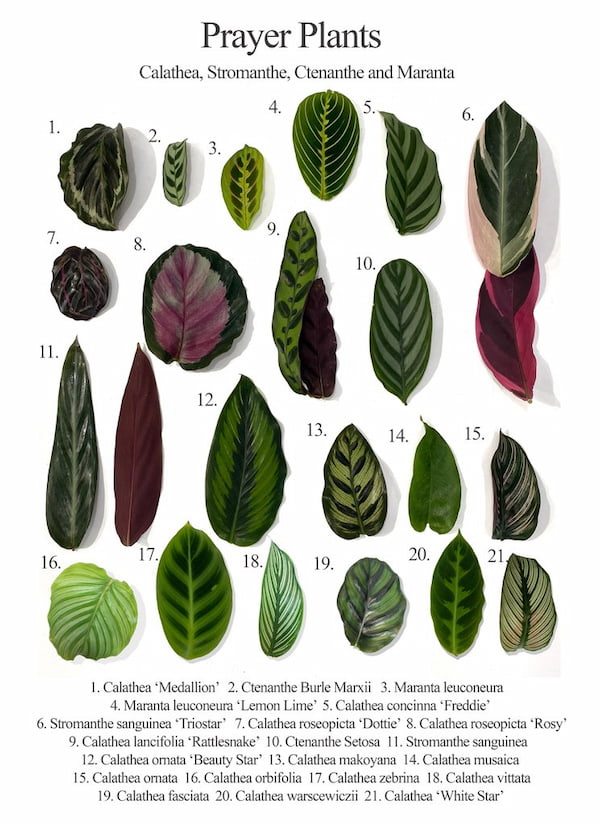
Prayer Plant Problems
Prayer Plant Leaves Curling
- Air too Dry
- Temperature too Low
Insect Pests
In winter, Prayer plants are mostly kept closed indoors for better care. Preserved for a long time in a warm, enclosed environment, Prayer plants are susceptible to insects that feed on the SAP inside the leaves, causing leaves to curl. It is necessary to spray drugs as soon as possible to control insect pests. In addition, proper ventilation should be carried out on sunny days for about one hour a day, so as to avoid re-infestation and benefit the growth of Prayer plants.
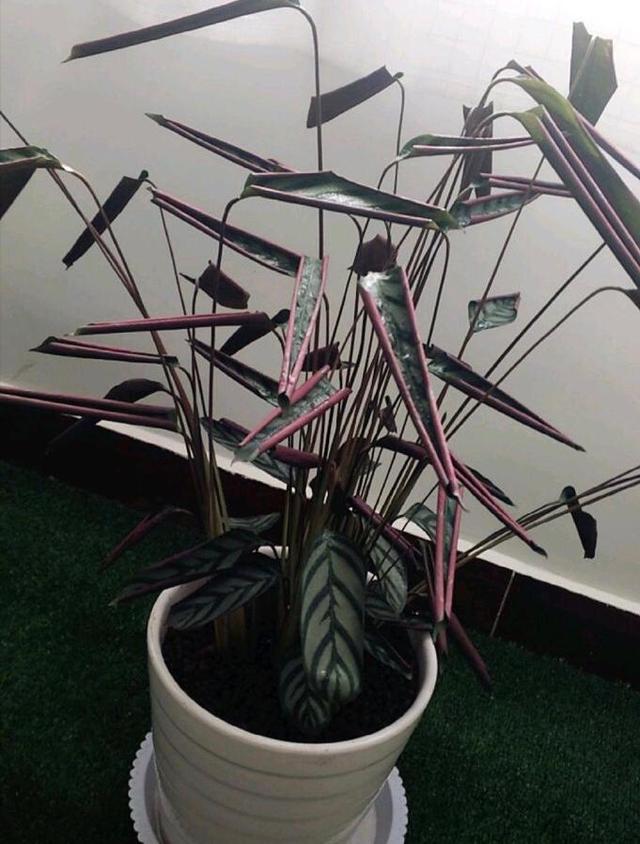
Prayer Plant Drooping
There are many reasons why the leaves of Prayer plants drooping. The first is caused by improper soil. You need to replace the loose new soil to meet the basic conditions of Prayer plants growth. The second is caused by unreasonable watering and fertilization. Ensure the normal watering and fertilization, promote discharge if too much water and fertilizer. The third is caused by improper temperature. Create a suitable environment for Prayer plants growth, keep it warm in winter.Prayer Plant Yellow Leaves
Prayer plants like a wet environment, so it is necessary to keep the soil and the air moist during curing. If too little water, Prayer plants will appear yellow leaves because of drought, but too much water can lead to Prayer plants roots being rotted, which also causes the yellow leaves. In addition to water, It is best to keep the humidity between 75% and 85% during prayer plant care. Because of overwatering, the roots of the plant can't breathe properly, which affects the plant's growth. The solution is to dig it up, trim away the rotten roots, and replant it in well-drained soil.Prayer plants love warm environments, and the best temperatures for them are between 20 and 30 degrees. When the temperature exceeds 35 degrees in summer, we need to provide shade for Prayer plants and spray water to cool them down, otherwise the high temperature will lead to yellow leaves of Prayer plants. It is necessary to keep the temperature above 10 degrees in winter, and if it falls below that, Prayer plants will get frostbitten and yellow leaves will also occur.
Prayer plants love semi-shade and are very afraid of direct sunlight. If Prayer plants are exposed to the sun, the leaves of the plants will get sunburned, resulting in yellow leaves. At this time, we need to transfer Prayer plants to a cool and ventilated environment and spray water to cool them down. At ordinary times, it is best to preserve them in an environment with sunlight scattering.
Read More:
Why Does My Prayer Plant Have Yellow Leaves
Is Prayer Plant Toxic to Cats
Prayer plants are not toxic to cats and dogs, you can grow them at ease.Prayer Plant Brown Tips
The leaves of Prayer plants appear brown tips, which are often infected with diseases. When plants get leaf spots diseases, they will appear brown round spots. It can become more serious if no immediate control measures are taken. Brown tips Leaves can be cut off to avoid spreading the disease to other leaves. In addition, it is necessary to apply with carbendazim, mizunamine emulsion or methyl thiobacillazim for targeted prevention and control.Prayer Plant Dying
Whether Prayer plants can be revived depending on their roots. If the root system is healthy, properly care and provided the right environment, it may still be revived and germinating next spring when temperatures rise again. But if the root system has dried up or rotted, it can't live and die. Prayer plants are evergreen and normally don't wither in the winter. Once withered, it indicates that there has been a poor growth condition. Here are steps on how to revive a prayer plant.- Pruning: When Prayer plants wither in winter, they need to be pruned as soon as possible. All the withered and yellow parts should be cut off, leaving only the healthy and fresh parts, which can reduce nutrient consumption and avoid bacteria. Note that grass ash should be applied to the cut after trimming.
- Temperature control: After pruning Prayer plants, they need to be moved to a warm place, and the temperature should be stable at about 15 degrees, not less than 10 degrees, so as to avoid being frozen again. If the indoor temperature is low, it can be covered with plastic bags to keep warm.
- Reduce watering: The growth of Prayer plants has basically stopped in the low-temperature environment in winter. In the later period, watering should also be reduced to dry the soil as a whole. When the soil is dry enough, water it properly to avoid root rot.
- Get more sun: The light in winter is very soft, which won't burn Prayer plants. At this time, it is recommended to put the Prayer plant in a good place for lighting, and let it bask more, so that it can accumulate more nutrients, so as to facilitate later recovery and growth. Provide the right conditions for it to sprout again next year.
Prayer Plant Problems - Prayer Plant Care
Prayer Plant Root Nodules/Root Bulbs
Prayer Plant root nodules are special nodules that grow on the roots of plants and are formed by symbiotic nitrogen-fixing bacteria in the parasitic tissues, which are used to synthesize nitrogen-containing compounds (such as proteins). Since the disease will be repeated after the root nodules grow, we need to isolate the Prayer Plant in the first time, wash the roots, change the soil and the pot. If we grow Prayer plants in the ground, it is suggested to change places. Completely remove the nodules with a knife, disinfect with diluted alcohol and place the prayer plant in a new basin, and then water with the root-knot nematode. It should be noted that, because the nodule will be repeated, so we must pay more attention to the growth of the Prayer Plant root nodule after, which may be repeated several times before it will be completely removed.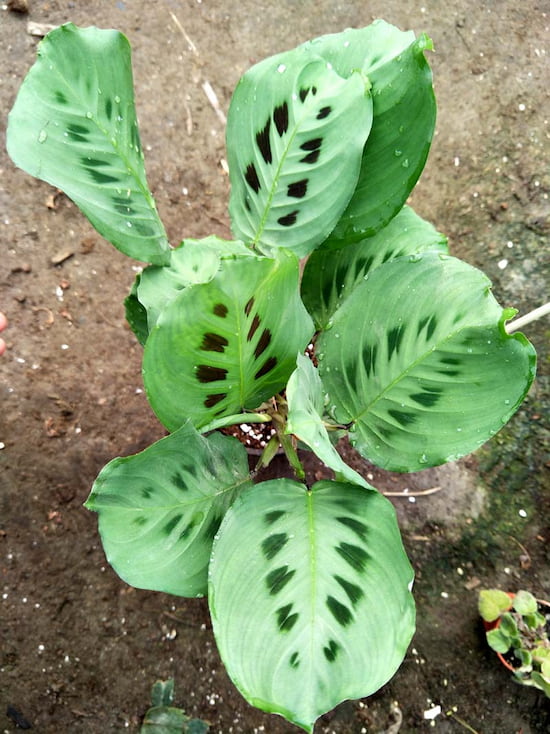
Prayer Plant Root Rot
The root rot of Prayer plants is caused by the fact that we use too larger pot, the soil silts up, and the watering is not well controlled. In particular, indoor ventilation, your soil deposition for a long time will cause root rot. If the roots and leaves are found to be rotten, timely treatment can also save the Prayer Plant.After discovering that the Prayer Plant has rotted roots, remove the soil at the root in time, check the root system and clean all the rotted roots. Even if all the roots are rotted, as long as the position between the root and the leaves is intact and will not be scattered, it can be saved. Remember that when pruning the rotting roots of Prayer Plant, do not retain any rotting positions. After pruning, find some rooting solution, mix some carbendazim water, and then soak the trimmed positions of its roots in water for one to two hours. After soaking, take out the Prayer Plant. If the leaves are rotting, clean them up.
Prepare new soil to cultivate with good air permeability, it is best to use river sand and nutrient soil. Nutrient soil must be exposed to the sun for a while to ensure that there are no pests eggs and bacteria inside. Choose a small pot to ensure the air permeability of the soil and bury the Prayer Plant in the soil. Pour the rooting solution on the first watering, and then pour some carbendazim on the Prayer Plant to prevent it from rotting and make it grow new roots quickly. After planting the Prayer Plant in such a way, put it in a place with bright light and good ventilation. When the soil becomes dry on the surface of the pot, water it in time. After about a month, its root system will grow well and there will be obvious small leaves. We can gradually increase the appropriate light to it. If the growth rate of Prayer Plant is relatively fast, we can fertilizer it and care for prayer plant normally.
How to Transplant Prayer Plant
How to transplant Prayer Plant? Prayer Plant transplantation is best carried out in spring and autumn when the climate is suitable and the temperature can reach about 20℃. Transplanting Prayer plants takes only four steps.- Choose a pot
- Prepare soil
- Choose seedlings
- Transplant Prayer Plant
Latest Updated
- Benefits of Bugleweed - 7 Science-backed Health Benefits
- Bugleweed Dangers & Side Effects - Is It Poisonous?
- How to Plant Evergreen Trees - What You Should Know
- When to Plant Evergreens - Grow Guide for Evergreen Trees
- 12 Wonderful Evergreen Shrubs for Your Garden
- 12 Popular Evergreen Plants with Pictures for Beginners
- When And How To Prune A Lilac Bush Like a Pro
- How to Grow & Care for Lilac Vine (Hardenbergia Violacea)
- Japanese Lilac Tree (Syringa Reticulata) Care & Propagation Guide
- Shumard Oak Pros and Cons - What to Know
Popular Articles
- Winter maintenance of Antirrhinum Majus
- How to Grow Terminalia Mantaly Tree
- How to Grow and Care for Crossostephium Chinense
- How to grow Antirrhinum Majus in spring
- Peristeria Elata (Dove Orchid) Profile: Info & Care Guide
- Underwatered Snake Plant (Sansevieria Trifasciata) - Signs And How To Fix
- How to Care for Brazilian Jasmine Plant (Mandevilla Sanderi)
- How to Grow & Care for Graptopetalum Purple Delight in Summer
- Rosa Chinensis (China Rose): Plant Growing & Care Tips
- How to Care for Baby Sun Rose (Aptenia Cordifolia)
